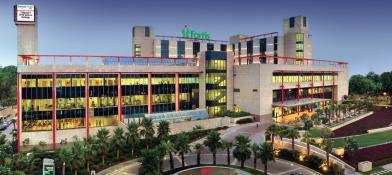Coronary Bypass Surgery
What is Coronary Artery Bypass surgery?
- Coronary artery bypass surgery (CABG) refers to a procedure in which medical professionals take blood vessels from another portion of the body to create new places for blood rich in oxygen to flow around, or "bypass," blocked or obstructed coronary arteries to the cardiac muscle.
- Arteries of an individual's heart become narrowed or clogged over time when fats, cholesterol, as well as other substances accumulate to form plaque.
- When the plaque buildup breaks open and a blood clot forms, the flow of blood to the heart can become obstructed. This can lead to chest discomfort, known as angina, or a heart attack.
Alternative names for this surgery are:
- Coronary artery bypass grafting.
- CABG — pronounced "cabbage."
- Coronary artery bypass graft surgery.
- Heart bypass surgery.
Why is Coronary Artery Bypass surgery done?
Coronary artery bypass surgery is conducted to restore blood flow around an obstructed heart artery. The surgery may be performed as an emergency treatment for a myocardial infarction if other immediate therapies aren't working.
Healthcare providers might advise coronary artery bypass surgery if an individual has the following:
- There is a blockage in the left main heart artery, which supplies a lot of blood to the cardiac muscle.
- Serious narrowing of the leading heart artery.
- The narrowing of several heart arteries causes severe chest pain. The narrowing decreases blood flow to the heart, even during light exercise or rest.
- More than one diseased heart artery and an individual's lower left heart chamber don't work well.
- A blocked heart artery cannot be treated with coronary angioplasty. This less-invasive treatment utilises a balloon on the tip of a thin tube known as a catheter to dilate the artery. A small coil known as a stent is typically used to open the artery.
- An angioplasty with or without a stent that hasn't worked. For instance, an artery narrowed again after stenting.
What happens during the procedure?
- Coronary artery bypass surgery is a primary surgery performed in a hospital. Doctors trained in heart surgery, (known as cardiovascular surgeons), perform the surgery. Heart doctors, known as cardiologists, and a team of other providers aid patient care.
- Prior to a patient goes into the operating room, a healthcare provider inserts an IV into the patient's forearm or hand and gives a medication called a sedative to aid the patient relax.
When a patient is in the operating room, the patient can expect these things:
- Anesthetics: The patient receives a combination of medications through the IV as well as a face mask. These medications put the patient in a pain-free, sleep-like state. This is called general anesthesia.
- Breathing machine: A care provider puts a breathing tube into patient's mouth. This tube attaches to a breathing machine known as a ventilator. The machine breathes for patient during and immediately post the surgery.
- Heart-lung machine: During surgery, a heart-lung machine lets blood as well as oxygen flowing through patient's body. This is called on-pump coronary bypass.
Coronary artery bypass surgery generally takes about 3 to 6 hours. How long surgery takes relies on how many arteries are obstructed.
A surgeon typically makes an extended cut down the center of the chest along the breastbone. Then, the surgeon spreads open the rib cage to depict the heart. Post the chest is opened, the heart is temporarily stopped with medication, and the heart-lung machine is turned on.
The surgeon excises a portion of healthy blood vessels, often from inner part of the chest wall or from the lower leg. This piece of healthy tissue is known as a graft. The surgeon adheres the ends of the graft below the blocked heart artery, creating a new pathway for blood to flow surrounding the blockage. More than one graft may be utilised during coronary artery bypass surgery.
A few variations of coronary artery bypass surgery comprise:
Off-pump (or beating-heart surgery): Certain instances, a heart-lung machine is not utilised during coronary artery bypass surgery. Instead, the surgery is conducted on the beating heart. Special equipment stabilizes the specific portion of the heart being operated on. This type of surgery can be tough because the remaining heart is still moving. It's not a choice for everyone.
Minimally invasive surgery: A heart surgeon conducts the surgery through minor cuts in the chest. Minimally invasive heart surgery might be known as port-access (or keyhole surgery).
Post the surgery is done, the health care providers restore patient's heartbeat in the operating room and stop the heart-lung machine. The surgeon utilises wire to close the chest bone. The wire stays in body post the bone heals.
Benefits of heart bypass surgery
The perk of surgery comprises:
- Improved sleep – thanks to enhanced manifestations of conditions such as less pain from angina as well as peripheral arterial disease.
- Enhanced mood as well as mental health – due to reduced likelihood of angina, heart attack, stroke, peripheral arterial disease, as well as other conditions caused by coronary heart disease.
- More zing (energy) – everyday tasks and physical activities become more accessible and enjoyable.
Risks: Coronary Artery Bypass Grafting
Probable risks of coronary artery bypass graft surgery (CABG) comprise:
- Bleeding during or post the surgery.
- Infection at the cut site
- Pneumonia
- Problems linked with breathing.
- Pancreatitis
- Renal failure
- Unusual heart rhythms
- Failure of the graft
- Mortality
- Blood clots that can cause heart attack, stroke, or lung issues.
To summarise, coronary artery bypass grafting (CABG), also known as heart bypass surgery, is a medical procedure to improve flow of blood to the heart. It may be required when the arteries supplying blood to the heart, referred to as coronary arteries, are narrowed/obstructed. The benefits and risks of heart bypass surgery differ for everyone and rely on the seriousness of an individual's heart ailment, the type of operation the individual needs, the individual's age, and his/her overall health.


























